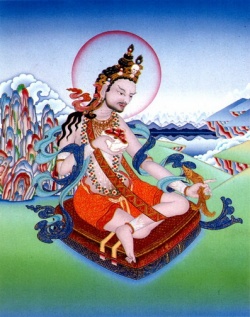Mahasiddha: greatly accomplished
Skt., mahasiddha: greatly accomplished
Tib., grub-thob: accomplished
Contrasting with the scholastic and academically orientated Buddhist tradition in sixth to twelfth century India, the Mahasiddhas essentially represent the path of self-realization through experience.
Rather than being monks, these "Greatly (maha) Accomplished (siddha) Ones" were adepts of spontaneity and individuality. Coming from a wide spectrum of social backgrounds, these eighty men and four women followed the path of the Tantric yogi/magician in order to attain liberation and enlightenment within one lifetime. Their experiences, attainments and teachings are the very root of Vajrayana; and especially of the Mahamudra- and Dzogchen teachings.
Their number, 84, should not necessarily be taken as a historical fact. Rather, it corresponds to the Indian concept of there being 84 siddhi (accomplishments in the sense of 'magical' skills) one can attain during one's path toward realization.
Although both Padmasambhava and Milarepa are not among these eighty-four adepts, their lives, practices, spirits and teachings are very much connected to them. The tradition of the Mahasiddhas has been carried through time mainly by the Nyingmapa and the Kagyudpa schools of Tibetan Buddhism, as well as by the non-monastic tradition known as Ngakpa.
Most famous among the Great Siddhas are Indrabhuti, Luipa, Naropa, Saraha, and Tilopa; yet all Siddha biographies are beautiful, informative and educativr tales. In the accompanying alphabetical list of all eighty-four, their nicknames reveal just how different - and alive - these Tibetan Saints have been.
The exact genealogy and historical dates of the Mahasiddhas are not totally clear. Most have lived between 750 and 1150 - and the best "informed guess" about their genealogy has been published by Keith Dowman in his Masters of Mahamudra.
